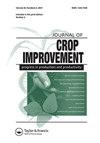Genetic relationship of the winter barley varieties assessed by the inter-Primer Binding Site (iPBS) DNA profiling method
IF 1.5
Q3 AGRONOMY
引用次数: 0
Abstract
ABSTRACT Winter barley (Hordeum vulgare L.) is an important crop with great impact on the nutrition of the world population. Many of the barley varieties used in industry are obtained from private and public seed collection organizations. Understanding the relationships among barley genotypes within these collections is crucial for breeding and maintenance. The objective of this study was to determine the genetic diversity in winter barley from the Kuban State Agrarian University collection by using DNA-profiling polymerase chain reaction (PCR) methods based on a single primer complementary to the primer binding site (PBS) region downstream of the long terminal repeat (LTR) for retrotransposons. In total, 1293 PCR amplicons were identified, of which 646 were polymorphic. Barley genotypes from this collection were mainly divided into two populations based on their geographical origin. Analysis of Molecular Variance (AMOVA) results indicated a high level of genetic diversity among the barley genotypes (83%). Relationships of the studied barley genotypes and their ancestry were established using clustering and Principal coordinate analysis (PCoA) analysis. The results of PCoA and clustering were similar and close genetic relationships of selected accessions were confirmed. Surprising results were obtained for Timofei and Vasya genotypes that are not supposed to be closely related, but were positioned together. Similar unexpected results were shown for Samson and Iosif varieties. Nevertheless, obtained data can be useful for planning of future crossing by breeders using distantly related crossing pairs.利用引物结合位点(iPBS)分析冬大麦品种的亲缘关系
摘要冬大麦(Hordeum vulgare L.)是一种对世界人口营养有重大影响的重要作物。工业上使用的许多大麦品种都是从私人和公共种子收集组织获得的。了解这些群体中大麦基因型之间的关系对于育种和维护至关重要。本研究的目的是通过基于与逆转录转座子的长末端重复序列(LTR)下游的引物结合位点(PBS)互补的单个引物的DNA图谱聚合酶链式反应(PCR)方法,确定库班州立农业大学收集的冬大麦的遗传多样性。共鉴定出1293个PCR扩增子,其中646个具有多态性。根据地理来源,该群体的大麦基因型主要分为两个群体。分子方差分析(AMOVA)结果表明,大麦基因型之间具有较高的遗传多样性(83%)。利用聚类和主坐标分析(PCoA)建立了所研究的大麦基因型与其祖先的关系。PCoA和聚类结果相似,并证实了所选材料之间的密切遗传关系。Timofei和Vasya基因型获得了令人惊讶的结果,它们本不应该密切相关,但定位在一起。Samson和Iosif品种也出现了类似的意外结果。然而,所获得的数据对于育种家使用远缘杂交对规划未来的杂交是有用的。
本文章由计算机程序翻译,如有差异,请以英文原文为准。
求助全文
约1分钟内获得全文
求助全文
来源期刊

Journal of Crop Improvement
Multiple-
CiteScore
3.30
自引率
7.70%
发文量
42
期刊介绍:
Journal of Crop Science and Biotechnology (JCSB) is a peer-reviewed international journal published four times a year. JCSB publishes novel and advanced original research articles on topics related to the production science of field crops and resource plants, including cropping systems, sustainable agriculture, environmental change, post-harvest management, biodiversity, crop improvement, and recent advances in physiology and molecular biology. Also covered are related subjects in a wide range of sciences such as the ecological and physiological aspects of crop production and genetic, breeding, and biotechnological approaches for crop improvement.
 求助内容:
求助内容: 应助结果提醒方式:
应助结果提醒方式:


